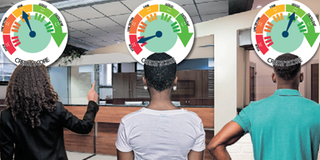How to improve your creditworthiness

Credit scores are sourced from credit reports stored by credit bureaus and they assist banks in determining your ability to repay your loan back on time.
If Alice, Pam and John walked into a bank looking for a loan to buy an apartment unit they just saw in an advert, what interest rates would they be given?
Let’s say Alice is 35 years old. She has never borrowed before but she has a good consistent income from a stable job. Pam, 40 owns a business. She has a business loan already but she has not been repaying her instalments for the past six months. She really wants this apartment because it is a good deal and it might put some rental income in her pockets. John,37 also owns a business.
He has a car loan and a mobile loan and he is repaying well, on time. Owning the nice apartment means he will not be paying rent and with the extra space at home, he can set up a home office and put in more hours into the business. If you were the loan officer at the bank, what risk level would you attach to each of them and what would be their interest rates? The credit sector plays a big role in real estate. It enhances our ability to make investments we would never make with our meagre income.
The Risk-based pricing model
In 2016, a bill was introduced to cap interest rates at 4 per cent above the Central Bank of Kenya’s (CBK) base rate which was 10 per cent at the time. This meant banks could not lend at more than 14 per cent. This bill was later repealed in November 2019, and the CBK came up with the Kenya Bankers’ Service Charter. The charter was meant to improve transparency and equity in access to credit.
As John Wachiuri, the Chief Risk Officer at Family Bank explains, fairness is one of the pillars under this charter, and the CBK required banks to develop a risk-based pricing model under this pillar. The model introduced a methodical and standardised way of determining the creditworthiness of a customer.

Family Bank Chief Risk Officer John Wachiuri.
Banks had various ways of appraising customers but this model introduced a transparent criterion which to a great extent puts a lot more power and responsibility in the customer’s hands when it comes to interest rates. In a nutshell, your credit score and your risk profile determine the interest rates you attract. The lower your credit score the higher your interest rate.
Credit scores are sourced from credit reports stored by credit bureaus and they assist banks in determining your ability to repay your loan back on time. In addition to your credit report, the bank will look at other factors to establish your risk profile.
“When it comes to the risk-based pricing model, there are two parameters. We have the base rate and the risk premium. The base rate is the minimum rate which a bank can use to lend to a customer, assuming the customer has no risk at all. Each bank has its base rate which is set in consideration with several factors like the cost of operating the bank, cost of equity, the cost of money (interest paid to depositors) and other macroeconomic factors like inflation, unemployment and currency exchange rate among others. Additionally, every customer has their unique risk premium depending on their risk profile and again, banks have a way of determining the risk premium for every customer. It could be on a scale of one to five, where five is excellent and one is poor or worst. They will look at qualitative and quantitative factors such as the frequency at which a customer has been paying their facilities, their capital or collateral. Qualitative factors could include the strength of a company’s management (if the borrower is a company), its shareholders and the industry the company operates in”.
All these factors help banks determine the risk profile of a borrower. The overall interest rate a borrower gets on their loan is a summation of the base rate and the risk premium. If the base rate is 12.7 per cent, for instance, and your individual risk premium is four per cent then your interest rate would be 16.7 per cent.
This model of determining risk is supposed to be transparent and the customer gets to understand why their risk premium is high or low. Disciplined borrowers are also rewarded with good rates which improves the relationship between lenders and borrowers.
What’s your risk profile?
The model gives banks a scientific way to determine a customer’s ability to pay back credit and banks have been implementing it gradually since its introduction. It is supposed to apply to all the customers and loan products including mortgages and personal loans.
At this point, if you are yet to borrow a loan since the model was introduced you are probably wondering what your risk profile would look like and what you can do to keep it low. As we have already established, a risky borrower is someone with a low credit score and the risk parameters attached to them are very high. And there are various reasons why one would attract a “high risk” profiling.
“Number one is if a customer has taken a loan out there or in a bank and they are late in their repayments or they have not paid at all then their risk premium will be high. Customers who are in business and they have challenges with their cash flow, those who come for secured facilities and they do not have a strong collateral or do not have any collateral also attract a higher risk rating,” If for instance, you offer a piece of land as collateral but it is in a swampy or riparian area, that will affect your score. But these are just a few factors that banks will consider.
The five Cs of credit
Lenders adhere to the five Cs of credit when appraising customers. These Cs include character, capital, capacity, collateral and conditions. Character refers to a customer’s integrity which can be seen in their credit history; whether they’ve borrowed before and how they’ve been paying back their loans. “Some people may struggle to pay because they were laid off or they have other challenges but if there is goodwill and we can clearly see they are trying then they have good character”.

In 2016, a bill was introduced to cap interest rates at 4 per cent above the Central Bank of Kenya’s (CBK) base rate which was 10 per cent at the time. This meant banks could not lend at more than 14 per cent. This bill was later repealed in November 2019, and the CBK came up with the Kenya Bankers’ Service Charter. The charter was meant to improve transparency and equity in access to credit.
Capacity is the customer’s ability to pay back a loan based on their cash flow or income. Collateral is security. Some loans are secured and others are unsecured. For secured loans, collateral is what you are providing as security. It could be a vehicle, land or a house. Capital is the contribution a customer is making.
This contribution could come from their savings or money they’ve earned from a business transaction. Finally, conditions are the terms of repaying the loan such as the time frame, monthly, instalments and rates versus the customer’s capacity. Essentially, these five Cs are dissected to determine your risk profile.
So, how would Alice, Pam and John be profiled? Alice has no credit history, which increases her risk because banks are not able to fully judge her character. But on the flip side, her income is stable and that makes her less risky. Her risk premium is likely to be medium.
For Pam, having defaulted for six months is already a red flag. “Six months is above the criteria we use to rate customers under non-performing loans. If you default over 90 days, then you fall under the non-performing category. Banks are in the business of financial intermediation, and the key objective is that any coin lend out is paid back. Giving this customer additional credit is quite risky even when they have good collateral because they’ve already presented signs of inability to pay back what they already owe. Their score will be significantly affected.
Learning points
In John’s case, several factors will come into play. For instance, the one-third rule whereby a borrower should at least take home a third of their salary after all their deductions will be a strong consideration. If one has too many loans such that they are not able to take home a third of their salary, then that’s risky but if they are still able to get more credit and take home a third or more then that’s good.
“We will look at their ability (capacity) to pay the loan in terms of their cash flow. Are they employed or in business? If they are employed. We look at their take-home salary versus the amount they want to borrow and compare it with their instalments. With multiple loans, the key thing we look at is whether they are being paid. The third factor is their security. We do a valuation on the security and if it looks good then they get a good score”.
The risk-based model has been a game-changer in the credit sector, which is often described as the backbone of the economy, supporting multiple sectors. There are several areas borrowers can work on to improve their experiences when borrowing. For instance, Wachiuri says, “For us to profile our customers we need information from them. The availability of that information and the quality are two different things. This information includes business records, especially for MSMEs.





